ECO mode TOYOTA PRIUS C 2012 NHP10 / 1.G Owners Manual
[x] Cancel search | Manufacturer: TOYOTA, Model Year: 2012, Model line: PRIUS C, Model: TOYOTA PRIUS C 2012 NHP10 / 1.GPages: 552, PDF Size: 8.27 MB
Page 11 of 552
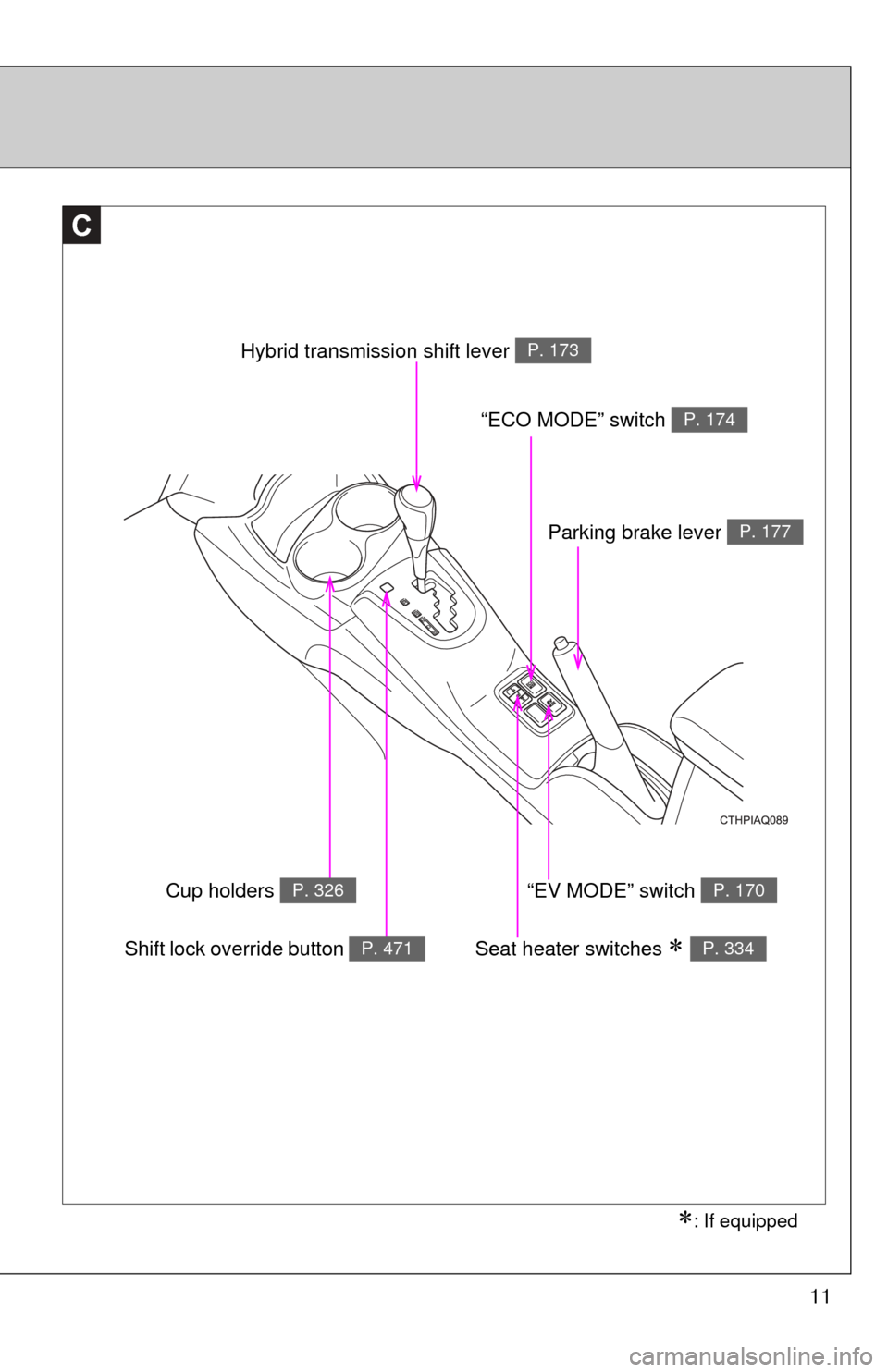
11
C
Hybrid transmission shift lever P. 173
Parking brake lever P. 177
ŌĆ£ECO MODEŌĆØ switch P. 174
ŌĆ£EV MODEŌĆØ switch P. 170
Seat heater switches ’Ƭ’ĆĀP. 334Shift lock override button P. 471
’Ƭ: If equipped
Cup holders P. 326
Page 42 of 552
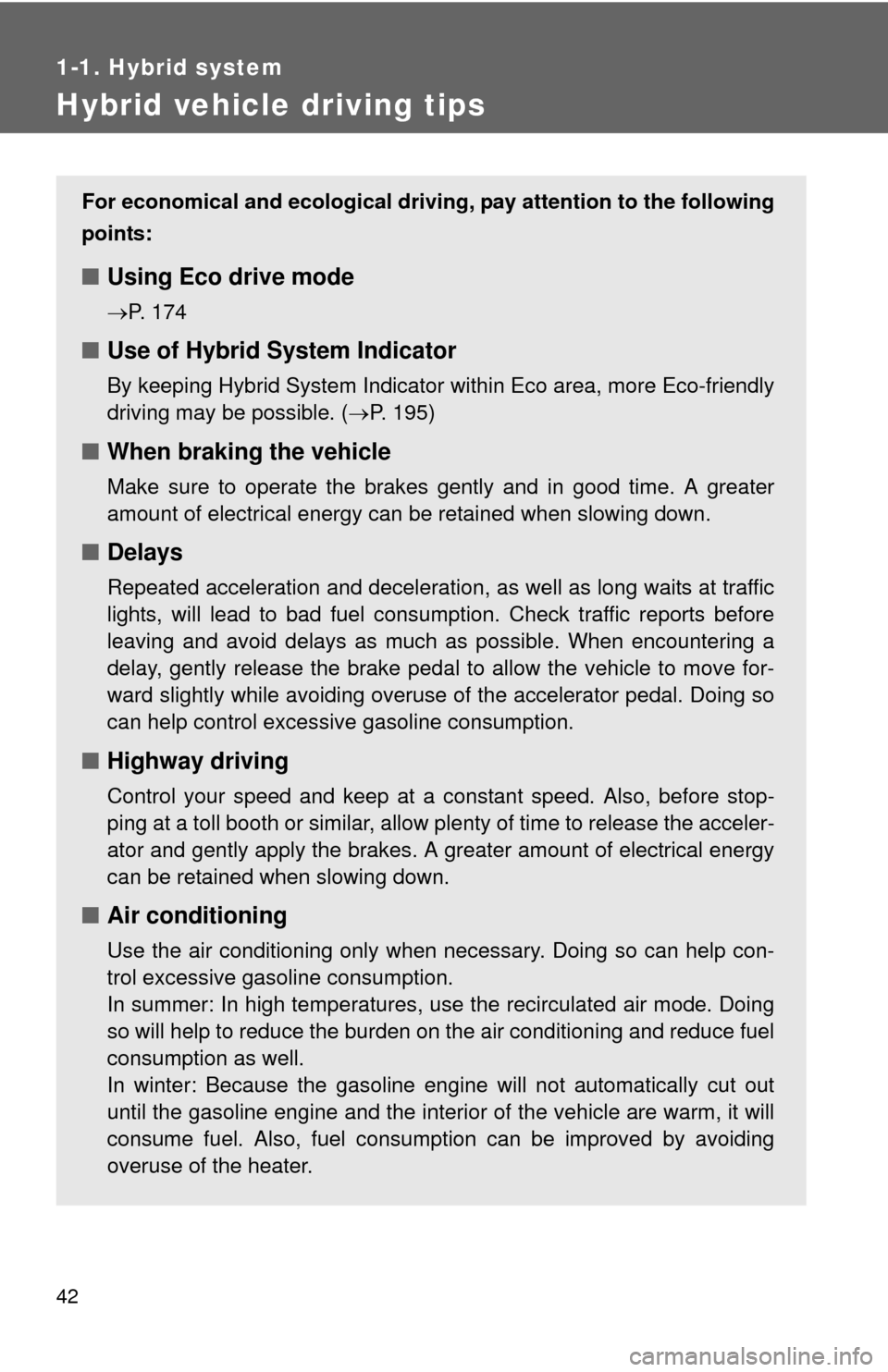
42
1-1. Hybrid system
Hybrid vehicle driving tips
For economical and ecological driving, pay attention to the following
points:
Ō¢Ā Using Eco drive mode
’é«P. 174
Ō¢ĀUse of Hybrid System Indicator
By keeping Hybrid System Indicator within Eco area, more Eco-friendly
driving may be possible. ( ’é«P. 195)
Ō¢ĀWhen braking the vehicle
Make sure to operate the brakes gently and in good time. A greater
amount of electrical energy can be retained when slowing down.
Ō¢ĀDelays
Repeated acceleration and deceleration, as well as long waits at traffic
lights, will lead to bad fuel consumption. Check traffic reports before
leaving and avoid delays as much as possible. When encountering a
delay, gently release the brake pedal to allow the vehicle to move for-
ward slightly while avoiding overuse of the accelerator pedal. Doing so
can help control excessive gasoline consumption.
Ō¢ĀHighway driving
Control your speed and keep at a constant speed. Also, before stop-
ping at a toll booth or similar, allow plenty of time to release the acceler-
ator and gently apply the brakes. A greater amount of electrical energy
can be retained when slowing down.
Ō¢ĀAir conditioning
Use the air conditioning only when necessary. Doing so can help con-
trol excessive gasoline consumption.
In summer: In high temperatures, use the recirculated air mode. Doing
so will help to reduce the burden on the air conditioning and reduce fuel
consumption as well.
In winter: Because the gasoline engine will not automatically cut out
until the gasoline engine and the interior of the vehicle are warm, it will
consume fuel. Also, fuel consumption can be improved by avoiding
overuse of the heater.
Page 52 of 552
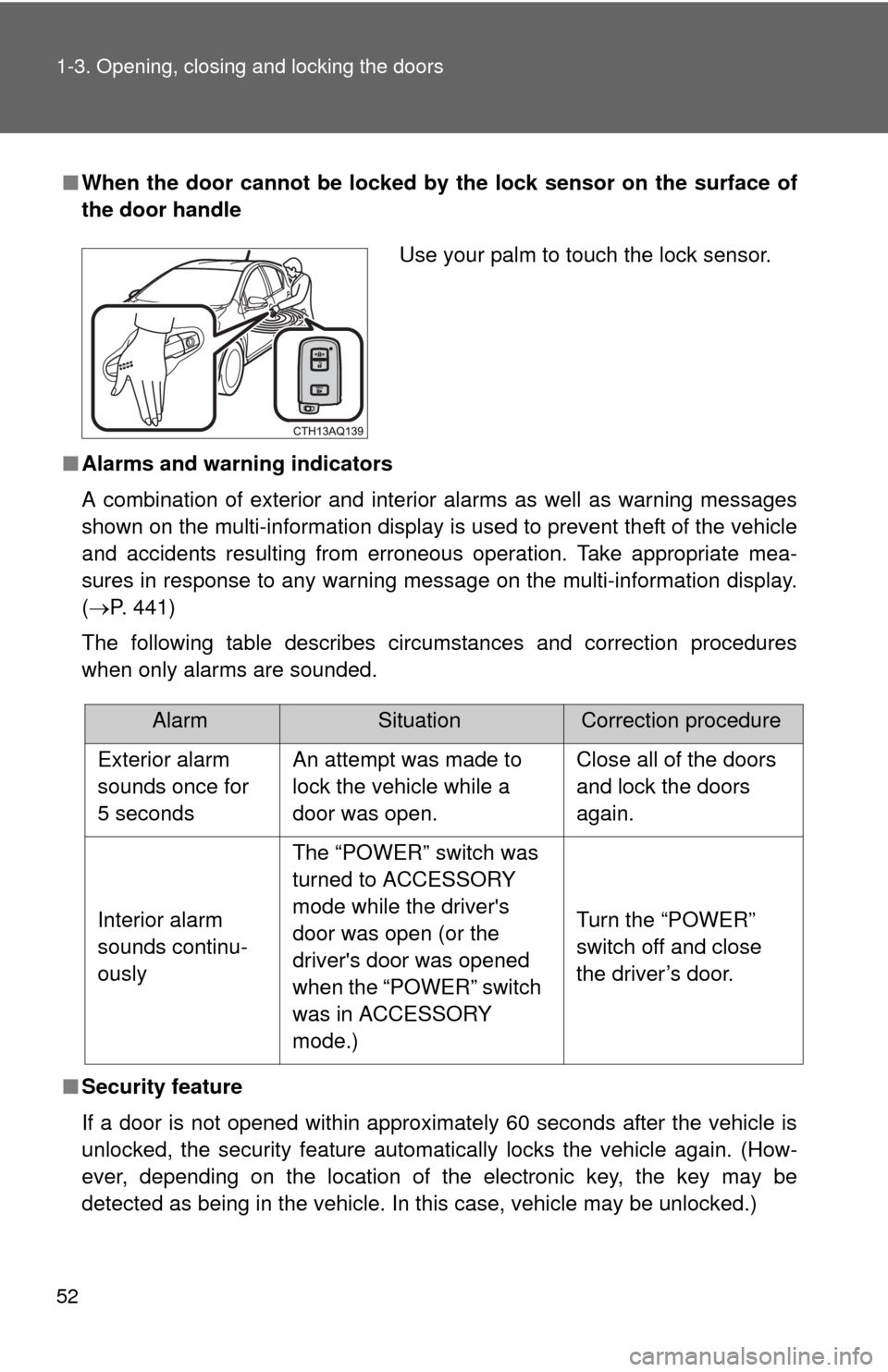
52 1-3. Opening, closing and locking the doors
Ō¢ĀWhen the door can not be locked by the lock sensor on the surface of
the door handle
Ō¢Ā Alarms and warning indicators
A combination of exterior and interior alarms as well as warning messages
shown on the multi-information display is used to prevent theft of the vehicle
and accidents resulting from erroneous operation. Take appropriate mea-
sures in response to any warning message on the multi-information display.
(’é«P. 441)
The following table describes circumstances and correction procedures
when only alarms are sounded.
Ō¢Ā Security feature
If a door is not opened within approximately 60 seconds after the vehicle is
unlocked, the security feature automatically locks the vehicle again. (How-
ever, depending on the location of the electronic key, the key may be
detected as being in the vehicle. In this case, vehicle may be unlocked.\
)
Use your palm to touch the lock sensor.
AlarmSituationCorrection procedure
Exterior alarm
sounds once for
5 seconds An attempt was made to
lock the vehicle while a
door was open. Close all of the doors
and lock the doors
again.
Interior alarm
sounds continu-
ously The ŌĆ£POWERŌĆØ switch was
turned to ACCESSORY
mode while the driver's
door was open (or the
driver's door was opened
when the ŌĆ£POWERŌĆØ switch
was in ACCESSORY
mode.) Turn the ŌĆ£POWERŌĆØ
switch off and close
the driverŌĆÖs door.
Page 56 of 552

56 1-3. Opening, closing and locking the doors
Ō¢ĀNotes for the entry function
ŌŚÅEven when the electronic key is within the effective range (detection
areas), the system may not operate properly in the following cases:
ŌĆó The electronic key is too close to the window or outside door handle,
near the ground, or in a high place when the doors are locked or
unlocked.
ŌĆó The electronic key is on the instrument panel, luggage cover or floor, in the door pockets or glove box when the hybrid system is started or
ŌĆ£POWERŌĆØ switch modes are changed.
ŌŚÅ Do not exit the vehicle with the electronic key placed on the instrument
panel or near the door pockets. Depending on the radio wave reception
conditions, it may be detected by the antenna outside the cabin and the
door will become lockable from the outside, possibly trapping the elec-
tronic key inside the vehicle.
ŌŚÅ As long as the electronic key is within the effective range, the doors may
be locked or unlocked by anyone.
ŌŚÅ Whether or not the electronic key is inside the vehicle, the hybrid system
could be started if the electronic key is near the window.
ŌŚÅ The doors may unlock if a large amount of water splashes on the door
handle, such as in the rain or in a car wash when the electronic key is
within the effective range. (The door will automatically be locked after
approximately 60 seconds if the doors are not opened and closed.)
ŌŚÅ The lock and unlock sensors may not work properly if they come into
contact with ice, snow, mud, etc. Clean the sensors and attempt to oper-
ate them again.
ŌŚÅ If the wireless remote control is used to lock the doors when the elec-
tronic key is near the vehicle, there is a possibility that the door may not
be unlocked by the entry function. (Using the wireless remote control to
unlock the doors may resume the function.)
ŌŚÅ If the door handle becomes wet while the electronic key is within the
effective range, the door may lock and unlock repeatedly. In that case,
follow the following correction procedures to wash the vehicle:
ŌĆó Place the electronic key in a location 6 ft. (2 m) or more away from the
vehicle. (Take care to ensure that the key is not stolen.)
ŌĆó Set the electronic key to battery-saving mode to disable the smart key system. ( ’é«P. 54)
Page 58 of 552

58 1-3. Opening, closing and locking the doors
Ō¢ĀElectronic key battery depletion
ŌŚÅThe standard battery life is 1 to 2 years.
ŌŚÅ If the battery becomes low, an alarm will sound in the cabin when the
hybrid system stops. (’é«P. 449)
ŌŚÅ As the electronic key always receives radio waves, the battery will
become depleted even if the electronic key is not used. The following
symptoms indicate that the electronic key battery may be depleted.
Replace the battery when necessary. ( ’é«P. 397)
ŌĆó The smart key system or the wireless remote control does not operate.
ŌĆó The detection area becomes smaller.
ŌĆó The LED indicator on the key surface does not turn on.
ŌŚÅ To avoid serious deterioration, do not leave the electronic key within 3 ft.
(1 m) of the following electrical appliances that produce a magnetic field:
ŌĆóTVs
ŌĆó Personal computers
ŌĆó Cellular phones, cordless phones and battery chargers
ŌĆó Recharging cellular phones or cordless phones
ŌĆó Glass top ranges
ŌĆó Table lamps
Ō¢Ā When the electronic key battery is fully depleted
’é«P. 397
Ō¢Ā If the smart key system has been d eactivated in a customized setting
ŌŚÅ Locking and unlocking the doors: Use the wireless remote control or
mechanical key. ( ’é«P. 61, 473)
ŌŚÅ Starting the hybrid system and changing ŌĆ£POWERŌĆØ switch modes:
’é«P. 474
ŌŚÅ Stopping the hybrid system: ’é«P. 474
Ō¢Ā Customization that can be co nfigured at Toyota dealer
Settings (e. g. operation signals) can be changed.
(Customizable features: ’é«P. 516)
Page 62 of 552
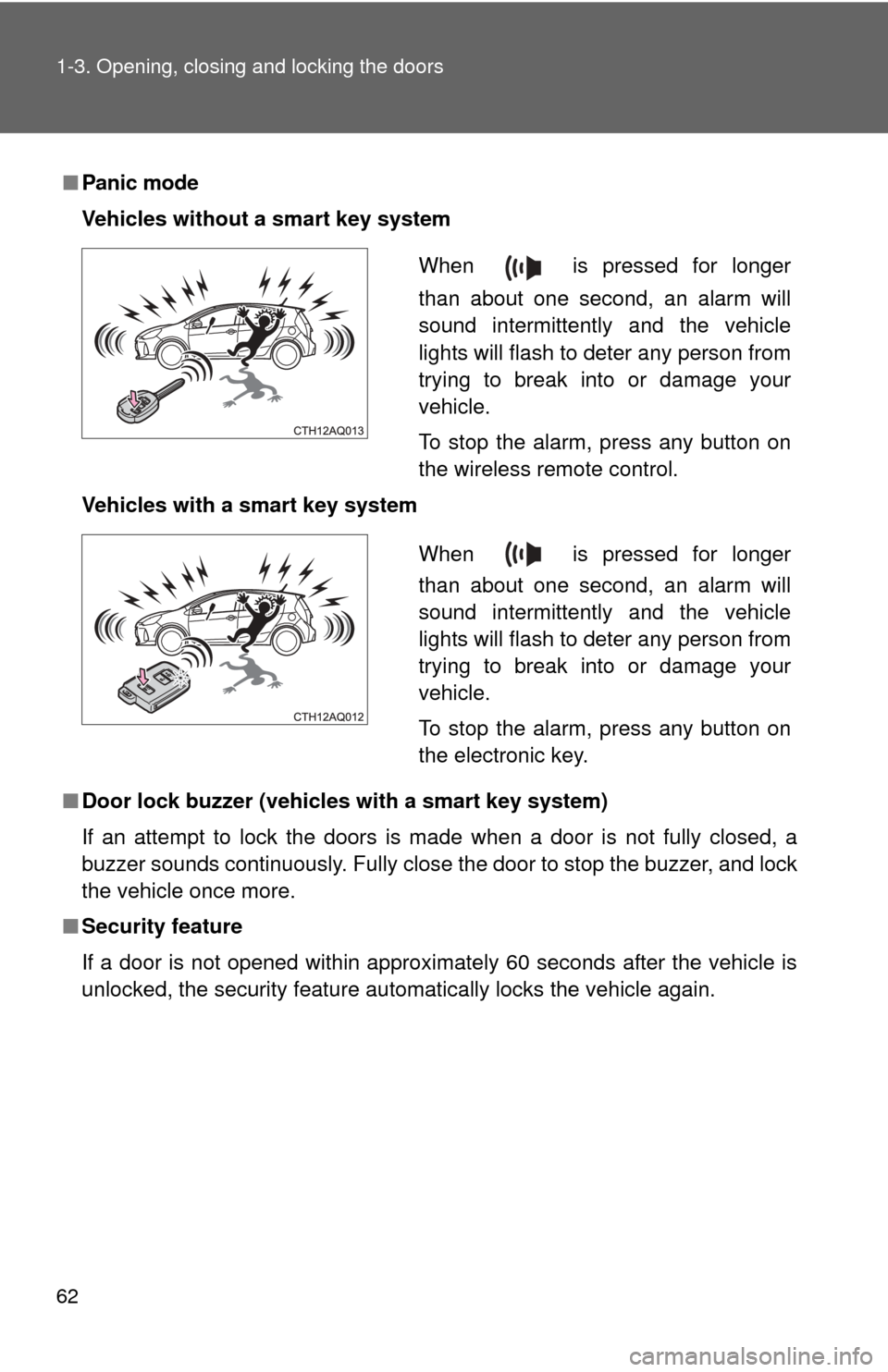
62 1-3. Opening, closing and locking the doors
Ō¢ĀPanic mode
Vehicles without a smart key system
Vehicles with a smart key system
Ō¢Ā Door lock buzzer (vehicl es with a smart key system)
If an attempt to lock the doors is made when a door is not fully closed, a
buzzer sounds continuously. Fully close the door to stop the buzzer, and lock
the vehicle once more.
Ō¢Ā Security feature
If a door is not opened within approximately 60 seconds after the vehicle is
unlocked, the security feature automatically locks the vehicle again.
When is pressed for longer
than about one second, an alarm will
sound intermittently and the vehicle
lights will flash to deter any person from
trying to break into or damage your
vehicle.
To stop the alarm, press any button on
the wireless remote control.
When is pressed for longer
than about one second, an alarm will
sound intermittently and the vehicle
lights will flash to deter any person from
trying to break into or damage your
vehicle.
To stop the alarm, press any button on
the electronic key.
Page 68 of 552
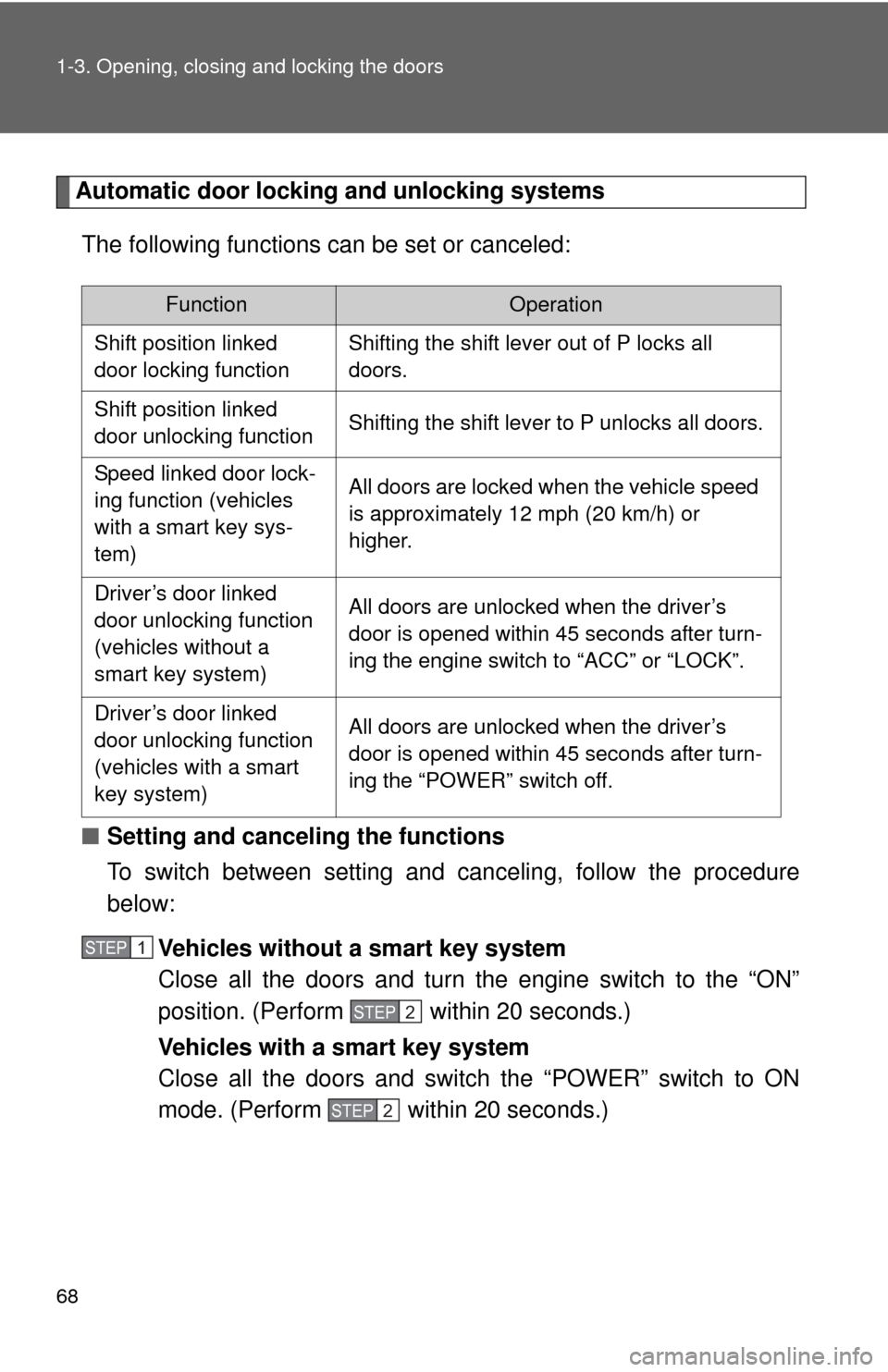
68 1-3. Opening, closing and locking the doors
Automatic door locking and unlocking systemsThe following functions can be set or canceled:
Ō¢Ā Setting and canceling the functions
To switch between setting and canceling, follow the procedure
below:
Vehicles without a smart key system
Close all the doors and turn the engine switch to the ŌĆ£ONŌĆØ
position. (Perform within 20 seconds.)
Vehicles with a smart key system
Close all the doors and switch the ŌĆ£POWERŌĆØ switch to ON
mode. (Perform within 20 seconds.)
FunctionOperation
Shift position linked
door locking function Shifting the shift lever out of P locks all
doors.
Shift position linked
door unlocking function Shifting the shift lever to P unlocks all doors.
Speed linked door lock-
ing function (vehicles
with a smart key sys-
tem) All doors are locked when the vehicle speed
is approximately 12 mph (20 km/h) or
higher.
DriverŌĆÖs door linked
door unlocking function
(vehicles without a
smart key system) All doors are unlocked when the driverŌĆÖs
door is opened within 45 seconds after turn-
ing the engine switch to ŌĆ£ACCŌĆØ or ŌĆ£LOCKŌĆØ.
DriverŌĆÖs door linked
door unlocking function
(vehicles with a smart
key system) All doors are unlocked when the driverŌĆÖs
door is opened within 45 seconds after turn-
ing the ŌĆ£POWERŌĆØ switch off.
STEP1
STEP2
STEP2
Page 97 of 552

97
1-4. Adjustable components (s
eats, mirrors, steering wheel)
1
Before driving
Ō¢ĀMirror angle can be adjusted when
Vehicles without a smart key system
The engine switch is in the ŌĆ£ACCŌĆØ or ŌĆ£ONŌĆØ position.
Vehicles with a smart key system
The ŌĆ£POWERŌĆØ switch is in ACCESSORY or ON mode.
Ō¢Ā When the mirrors are fogged up (veh icles with outside rear view mirror
defoggers)
The outside rear view mirrors can be cleared using the mirror defoggers.
Turn on the rear window defogger to turn on the outside rear view mirror
defoggers. ( ’é«P. 245)
CAUTION
Ō¢ĀWhen driving the vehicle
Observe the following precautions while driving.
Failure to do so may result in loss of control of the vehicle and cause an
accident, resulting in death or serious injury.
ŌŚÅDo not adjust the mirrors while driving.
ŌŚÅ Do not drive with the mirrors folded.
ŌŚÅ Both the driver and passenger side mirrors must be extended and properly
adjusted before driving.
Ō¢Ā When a mirror is moving
To avoid personal injury and mirror malfunction, be careful not to get your
hand caught by the moving mirror.
Ō¢Ā When the mirror defoggers are operat ing (vehicles with an outside rear
view mirror defoggers)
Do not touch the rear view mirror surfaces, as they can become very hot and
burn you.
Page 99 of 552

99
1-5. Opening and closing the windows and moon roof
1
Before driving
Ō¢Ā
The power windows can be operated when
Vehicles without a smart key system
The engine switch is in the ŌĆ£ONŌĆØ position.
Vehicles with a smart key system
The ŌĆ£POWERŌĆØ switch is in ON mode.
Ō¢Ā Operating the power windows afte r turning the hybrid system off
Vehicles without a smart key system
The power windows can be operated for approximately 45 seconds even
after the engine switch is turned to the ŌĆ£ACCŌĆØ or ŌĆ£LOCKŌĆØ position. They can-
not, however, be operated once either front door is opened.
Vehicles with a smart key system
The power windows can be operated for approximately 45 seconds even
after the ŌĆ£POWERŌĆØ switch is turned to ACCESSORY mode or turned off.
They cannot, however, be operated once either front door is opened.
Ō¢Ā Jam protection function (driverŌĆÖs window only)
If an object becomes caught between the window and the window frame,
window travel is stopped and the window is opened slightly.
Ō¢Ā When the power window does not close normally (driverŌĆÖs window
only)
If the jam protection function is operating abnormally and a window cannot
be closed, perform the following operations using the power window switch
on the driverŌĆÖs door.
ŌŚÅ Vehicles without a smart key system: After stopping the vehicle, the win-
dow can be closed by holding the power window switch in the one-touch
closing position while the engine switch is turned to the ŌĆ£ONŌĆØ position.
ŌŚÅ Vehicles with a smart key system: After stopping the vehicle, the window
can be closed by holding the power window switch in the one-touch clos-
ing position while the ŌĆ£POWERŌĆØ switch is turned to ON mode.
ŌŚÅ If the window still cannot be closed even by carrying out the operation
explained above, initialize the function by performing the following proce-
dure.
Page 102 of 552

102 1-5. Opening and closing the windows and moon roof
Ō¢ĀThe moon roof can be operated when
The ŌĆ£POWERŌĆØ switch is in ON mode.
Ō¢Ā Operating the moon roof after turning the hybrid system off
The moon roof can be operated for approximately 45 seconds after the
ŌĆ£POWERŌĆØ switch is turned to ACCESSORY mode or turned off. It cannot,
however, be operated once either front door is opened.
Ō¢Ā Jam protection function
If an object is detected between the moon roof and the frame while the moon
roof is closing or tilting down, travel is stopped and the moon roof opens
slightly.
Ō¢Ā Sunshade
The sunshade can be opened and closed manually. However, the sunshade
will open automatically when the moon roof is opened.